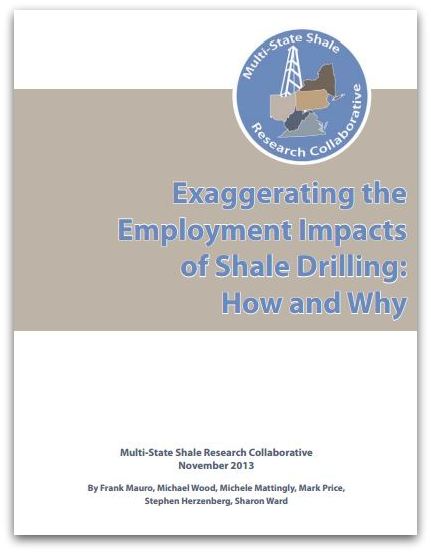
Over the last five years, firms with an economic interest in the expansion of drilling in the Marcellus and Utica shale formations — and their allies, supporters, and trade associations — have used a variety of tools and techniques to exaggerate the employment impacts of shale drilling. These strategies have ranged from the use of inappropriate measures, such as data on new hires, to represent job growth to the misleading attribution of all jobs in “ancillary” industries to the shale industry. Read the full report.
A review of statements by representatives of shale drilling firms and their allies makes the motivation for this exaggeration clear — to preclude, or at least to minimize, taxation, regulation, and even careful examination of shale drilling.
An explicit example of this “defense by exaggeration” strategy occurred on July 19, 2012, at a Harrisburg press conference during which the Pennsylvania Chamber of Business and Industry joined the U.S. Chamber of Commerce for the launch of its “Shale Works for US” campaign.
An accurate assessment of the short- and long-term impacts of shale development is necessary to adequately prepare drilling communities for the emergence of the industry, to estimate negative externalities associated with this industry (such as road damage, water treatment, and habitat loss), and to recover the costs of these externalities.
That accurate assessment must include defensible estimates of the number of jobs created in the industry, the wages associated with those jobs, the distribution of those jobs between in-state and out-of-state workers, and the relationship to total state employment. To answer those questions, the Multi-State Shale Research Collaborative has examined employment in the Marcellus and Utica Shale in six states: Maryland, New York, Ohio, Pennsylvania, Virginia, and West Virginia. Our findings include:
- New York, Ohio, Pennsylvania, and West Virginia have a long history of gas and oil production and a core of extraction-related jobs created well before the emergence of hydrofracking. Together, Ohio, Pennsylvania, and West Virginia had 38% of all producing wells in the country in 1990 and 32% in 2000.
- Some counties with a long history of mineral extraction have experienced a shift in employment from coal to shale extraction.
- Natural gas development has advanced quickly in the Marcellus Shale bringing with it some economic benefit to counties with significant drilling activity. Those impacts helped to insulate those counties from the worst effects of the Great Recession but had little overall impact on the state economy in any state studied.
- Job growth in the industry has been greatest (as a share of total employment) in West Virginia, but shale-related employment is less than 1% of total West Virginia employment and less than half a percent of total employment in all the other states.
- Region-wide, shale-related employment accounts for nearly 33,000 jobs, one out of every 794 jobs. The education and health sectors, by contrast, account for 4.5 million jobs in the region, one out of every six jobs.
- Between 2005 and 2012, less than four new shale-related jobs have been created for each new well. This figure stands in sharp contrast to the claims in some industry-finance studies, which have included estimates as high as 31 for the number of jobs created per well drilled.
- Employment estimates have been overstated, and the industry and its boosters have used inappropriate employment numbers, including equating new hires with new jobs and using ancillary job figures that largely have nothing to do with drilling, even after the flaws in those numbers have been brought to their attention.
- In addition, industry-funded studies, including those by Dr. Timothy Considine and co-authors, have substantially overstated the total jobs impact of the shale industry. With the passage of several years since the earliest Considine studies, we now know that actual Pennsylvania job growth has been much less than his initial estimates for 2011 and 2012.
- Finally, employment gains in some counties have already been reversed as drilling activity, which is highly sensitive to commodity prices, shifted to more lucrative oil shale fields in Ohio and North Dakota.
- In fact, shale-related employment across the six-state Marcellus/Utica region fell over the past 12 months for which data exist, from the 1st quarter of 2012 to the 1st quarter of 2013.